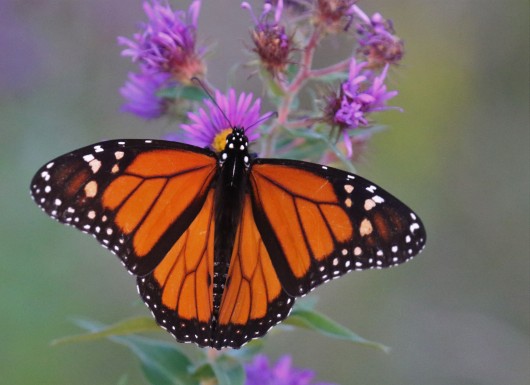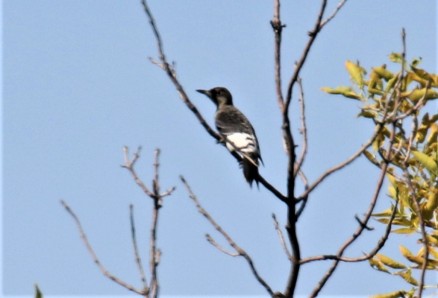Nebraska was to be the fifth and last Prairie State visited during what will hopefully be my penultimate trip as part of my 50/50/50 Adventure. On my original schedule, I had planned to get to Lincoln, Nebraska on Friday evening, September 20th, bird in the area on the 21st finding 50+ species and flying home to Seattle from Omaha that evening. That was the day that friend Michael Willison was free and birding with him would not just be fun but would be the best way to assure success as he is a great birder and also knows the area intimately. I have had great luck throughout my 50 state journey and this luck continued two fold in Nebraska.
Michael’s great birding buddy Knut Hansen was coming to Lincoln to bird with him and Michael was able to take off work on the 20th to bird with him. Due to the earlier success in Iowa than originally planned, I was able to arrive in Nebraska on the night of the 19th and also be available to bird on the 20th. It could not have worked out better. Getting to the punchline before the story itself, I birded with both Michael and Knut on both the 20th and 21st and we were able to find more than 50 species each day. It really was doubling the pleasure and doubling the fun as well as doubling the number of birds seeing more than 100 species combined over the two days. We had a great time.
Some more background. Michael was a top birder in Washington before leaving in 2013. A major feat was putting Eide Road on the map. Living nearby in Stanwood, Michael birded the hotspot religiously and established it as one of the best shorebird spots in the State with other great birds as well. It took him very little time to establish himself as a birding force in Nebraska and was the top Ebird birder there every year from 2013 through 2017 and ranks 4th all time. He is also an Ebird reviewer for the state. I first met Michael on our mad dash to see the Ross’s Gull that Charlie Wright had found at Palmer Lake in Washington on December 21, 2011. Knut Hansen had been along on that trip as well. I birded in Washington on numerous occasions that next year but Knut was piloting for Jet Blue and our paths did cross as much.
Ross’s Gull – Palmer Lake, Washington – December 21, 2011 (First birding with Michael and Knut)

Michael and Knut have birded together on many international trips and I listened with envy to many of their stories on the two days together. All of that would have made for a great trip regardless of the birds seen in Nebraska, but I was there primarily to get my 50 species. Knut was more interested in adding to his long list of birds photographed and Michael was serving as super guide to help each of us with our quests. I could not have had better help nor better company and that says a lot as it is evident that I had great help, great company, great birds and a great time on each of the states visited on this trip – and that has generally been the case in each state I have visited during this entire adventure. I am very fortunate.
Day 1 – September 20, 2019
There were thunderstorms with heavy rain on the night of the 19th but good weather greeted us as we began our birding on the 20th at an aptly named hotspot – the Marsh Wren Community Wetlands. Really great habitat. We circumnavigated the small lake giving us some good exercise and wonderful birds. Appropriately we had a Marsh Wren joined by Sedge Wren and House Wren. Carolina Wren has been seen there rarely but was not by us. Now if a Winter Wren had been seen, that would have been even better as I need a photo of that one.
House Wren

Sedge Wren (Left by me, right by Knut Hansen)


I have included two photos of one of the Sedge Wrens to demonstrate that I am more of a picture taker than a photographer. Mine on the left is “OK”. The one on the right by Knut Hansen has the focus and settings “just right”. Mine is a picture and his is a photograph. Moving towards that is a project for next year.
All told we had 40 species at this very enjoyable stop. One of my favorites there was a very cooperative Green Heron which we saw in the reeds at the marsh and perched on surrounding trees and in flight in between. We also had a Great Blue Heron but no Egrets or Night Herons which were possibilities.
Green Heron

We really had a good mix of birds with 4 duck species, 2 gallinaceous species (Pheasant and Turkey), 4 shorebirds including the only Wilson’s Snipes of my trip, 3 swallows and 4 icterids. The latter included both Eastern Meadowlarks (heard singing) and a few Yellowheaded Blackbirds. There was also a single Dickcissel in with a flock of blackbirds.
Wilson’s Snipe

On the path back to our car we saw at least 2 Brown Thrashers playing hide and seek with us and each other.
Brown Thrasher

Unfortunately Knut and I missed a flyby Sora seen by Michael so I was “only” at 39 species for the 100 minutes that we spent covering 3 miles there. This was clearly a great start and Michael was talking about the possibility of 100 species. I was willing of course, but first we needed 11 more. Six were quickly added on our way to and at the Whitehead Saline Wetland all supposed “gimmes”: Eurasian Collared Dove, Rock Pigeon, House Sparrow, American Crow, Turkey Vulture and Great Tailed Grackle with the latter being the first for my trip.
Great Tailed Grackle

We also had a large flock of Brown Headed Cowbirds. I had expected them to be common in all of these prairie states but found them only in two.
Brown Headed Cowbird

On our way to our next stop – Wilderness County Park – we passed a tower with a gathering of at least 150 Purple Martins. I have seen other swallow groups like this but never Purple Martins – probably close to as many Martins as I have seen over the past 5 years.
Purple Martins

At Wilderness County Park we had superb passerines, roaring past 50 species adding 16 new ones for the day. New species were Chimney Swift, Sharp Shinned and Red Tailed Hawks, Red Bellied Woodpecker, Yellow Throated and Red Eyed Vireos, Black Capped Chickadee, White Breasted Nuthatch, Gray Catbird, Eastern Wood Pewee, Common Grackle, Yellow, Yellow Rumped and Wilson’s Warblers, Northern Cardinal and a surprising Indigo Bunting. I cannot tell you which was number 50 but that milestone mattered only as meeting the specific “needs” of the 50/50/50 Adventure and it was clear that there was lots more great birding ahead.
I was particularly pleased to get good pictures of the Yellow Throated Vireo as my previous ones were pretty awful. These were much better. Getting a photo of the Red Eyed Vireo was nice as well.
Yellow Throated Vireo


Red Eyed Vireo

We were now at 62 species for the day and it was not yet noon. We had also added another mile plus of walking so I was feeling good about birds and exercise – feeling good about everything. All of our birding would be in Lancaster County and there were still some really good lakes to visit. Michael still had his sights set on 100 species for the day. At Yankee Hill State WMA, we added Red Headed Woodpecker and American Kestrel and then at Conestoga Lake we added more species including a Spotted Sandpiper that Knut spied in flight and some Chipping Sparrows only our second Sparrow species for the day. One of the Chippers had an odd deformed head but otherwise seemed healthy and active.
Chipping Sparrow with Deformity

Now over 70 species, it was time for lunch. On serious birding days, lunch is not a major undertaking – usually fast food, a sub and something liquid with a bathroom stop. I cannot even remember where we stopped this day, but we did actually sit down to eat and then we were quickly back in action.
Our next visit was to Pawnee Lake State Recreation Area. I had visited it the day before in sweltering heat and had a paltry 7 species in 35 minutes. This visit was the same length in somewhat less heat and in fact with threatening skies. We had twice as many species including some challenging ID’s between Forster’s and Common Terns – my first terns of my trip. My photo shows both terns and a Ring Billed Gull – all new for the day.
Three New Birds – Common (left) and Forster’s (center) Terns and Ring Billed Gull

A Ring Billed Gull is a relatively small gull so it is fun to see the size difference with the terns. Here are the comparative dimensions: Forster’s Tern – 13 inches long with a 31 inch wingspan; Common Tern – 12 inches long with a 30 inch wingspan; and Ring Billed Gull – 17.5 inches long with a 48″ wingspan. Interesting to note perhaps that the gull weighs 17.5 ounces while the two terns weigh in at 6 and 4.2 ounces respectively. Birds are truly lightweights making flight possible.
At this stop we also added Eastern Bluebird, Osprey, American White Pelican and Willow Flycatcher to our day list. It was here that we had our first real rain of the day – a heavy downpour that lasted less than 2 minutes. After that it was clear skies for the remainder of our birding. It is amazing that in my 47 days birding in this grand adventure this was only the second day with any rain and it had no impact whatsoever.
Eastern Bluebird

American White Pelican

I had also visited Branched Oak State Recreation Area the previous day. It is a huge area with a horseshoe shaped big lake. I had merely gone in to one entrance and scanned the lake finding Franklin’s Gulls and not much else. After a few minutes, I had departed. This day we would spend 2 hours there covering and recovering more than 10 miles. We had lots of birds – 44 species in all adding 16 species to our day total bringing us to 91. There were some very good birds but the rarest had to be an immature Sabine’s Gull – a rarity here and anywhere inland. I have seen them only on pelagic trips and in Nome Alaska. The gull was always distant so despite taking literally dozens of pictures, none are great, but no question on the identification.
Sabine’s Gull

We also had more Ring Billed Gulls and some new for the day Franklin’s Gulls. Another distant bird was a Black Tern.
Franklin’s Gull

This turned out to be a good spot for shorebirds as well although again they were mostly pretty distant. Species included Stilt Sandpiper, Least Sandpiper, Pectoral Sandpiper, Killdeer, Semipalmated Sandpiper, Semipalmated Plover, Long Billed Dowitcher, Sanderling and Lesser Yellowlegs. All but the Least and Killdeer were new for the day.
Shorebirds


At one point all of the shorebirds took off in a flash and Michael, Knut and I all simultaneously yelled “Peregrine” anticipating that there would be one scaring them off. A few seconds later one did indeed swoop by. It put on a great show hanging around for several minutes – chasing but not catching any of the shorebirds and then landing in shallow water providing a great photo opportunity.
Peregrine Falcon in Flight

Peregrine Falcon

Hard to choose which was the more exciting – the Sabine’s or the Peregrine but both were great shows and great birds. Other new birds for the day were Bald Eagle, Olive Sided Flycatcher, Cedar Waxwings, Double Crested Cormorants and House Finch. So we fell a bit short of Michael’s hoped for 100 species, but there were a number of misses for the day and the 91 species seen (not including the Sora seen by Michael only) still ranked 4th as a day total among all of the states to date in my Adventure. So officially Nebraska was completed state number 47 – completed a day earlier than planned which meant there was still a half day on the 21st to get out and bird some more.
Lincoln, Nebraska is the capital of Nebraska and is also the home of the University of Nebraska. This is football country and the locals, and residents from all over the state, take the Cornhuskers seriously. A little bit of a down time from the national prominence that the team once had but that has barely curbed the interest. We saw signs of this birding in some of the campgrounds surrounding the lakes as is evident from the sign below – at a campsite with an RV – one of many all with similar signs. There was a group of maybe 15 fans having fun together dressed in their Nebraska Cornhusker red attire. And this was the day before the game – which was an away game anyhow. We would see much more Cornhusker love the next day when we made a coffee stop in the Haymarket area near downtown Lincoln.

We celebrated the day with an excellent dinner at Copal Progressive Mexican Cuisine. I had a short rib dish that was as good as anything I have had – anywhere – super tender, well seasoned, more than reasonably priced and a very sizable helping. I would encourage anyone to try this rather unique place. https://www.copallnk.com/
“BEEF SHORT RIBS Our famous short ribs, slow cooked for 6 hours in a mixture of beer, Dijon mustard, agave honey and spices. Accompanied with avocado paste, mashed potatoes, meat juice reduction, rice and beans.” Yummy!!
Day 2 – Saturday September 21
On Saturday the 21st we were back in the field chasing Nebraska birds starting at the Lincoln Saline Wetlands Park. It was an even better start than the day before as we had 42 species some which were similar to the preceding day but with several new ones as well. A very late Orchard Oriole was new and rare for the time. Good looks but no photos. I was able to get a photo of a Blue Gray Gnatcatcher and an American Redstart neither very good though.
Blue Gray Gnatcatcher

There were better photos of two other warblers – Wilson’s Warbler and Common Yellowthroat.
Wilson’s Warbler

Common Yellowthroat
 There were many swallows – five different species including another large group of Purple Martins. We also had a Nashville Warbler – photo resistant and my first Yellow Warbler of the trip.
There were many swallows – five different species including another large group of Purple Martins. We also had a Nashville Warbler – photo resistant and my first Yellow Warbler of the trip.
Yellow Warbler

There were two new raptors for the visit, a Merlin and a Cooper’s Hawk and as we were leaving we had great views of Brown Thrashers and Gray Catbirds.
Cooper’s Hawk

Gray Catbird

The single species that was found most commonly in every one of these prairie states was probably the Blue Jay as their raucous calls were heard at almost every stop. They were mostly seen flying from one hidden perch to another. Northern Cardinals were also common although much less so than the Jays. Mostly it was their soft chips that we heard. We had good visuals of both of these species at this location.
Blue Jay

Northern Cardinal

With such a great start we took a break to visit the Haymarket Area in Lincoln for some coffee. It was game day morning and even though the Cornhuskers were playing an away game, the place was jumping full of football fans wearing every conceivable type of fan wear in red. We visited a store 100% dedicated to licorice. Who knew that Knut not just liked licorice but was also an aficionado.
Michael (Right) and Knut (Left)

And if anyone does not understand how Nebraska football is dominant in Lincoln and throughout the entire state, here is the view of the stadium I saw as I was entering the city. It is big. On game days it holds 90,000 people in the stands. So during the game, it is the thrid largest city in Nebraska behind Omaha and Lincoln itself.

OK, time to get back to the birds. We went to Antelope Park, essentially a walking/biking path in a nice residential area with trees and good passerine habitat. Our main target was a Mississippi Kite that had fledged a young bird there. It had not been reported for 5 days but Michael thought it likely that birders simply had not been there recently. He was right as it took us only a moment to find first one and then a second Mississippi Kite flying overhead.
Mississippi Kites


We had other good birds as well. One was our only Ruby Throated Hummingbird for the state – species number 100 in Nebraska. Similarly among the 24 species seen, we had our first Warbling Vireo, Hairy Woodpecker and Least Flycatcher.
Warbling Vireo

Least Flycatcher

Later at Michael’s home before leaving to get to the airport in Omaha and to return to Seattle, we had a Peregrine Falcon flyby – our 53rd species for the day. In some other states I had birded on my own before the official 50 species day and in a few I had found 50 or more species on my own. This time it was with the same birders as the day before but it was a much shorter day. If we had gone with the same drive and amount of time as the previous day, we may well have hit 100 species. As it was, combining the two days we had 105 species. The better measurement however, is that we had a lot of fun with great birds and experiences. I have to close with how super Michael was as a host and a guide and a friend.
So it is now 47 states completed leaving Kansas, Oklahoma and Arkansas to go. I cannot get out to bird again until late October or into November or December. Preliminary research suggests that 50 species in a day may be doable then. It would be fun to do these days as part of Christmas Counts in those states. We will see…
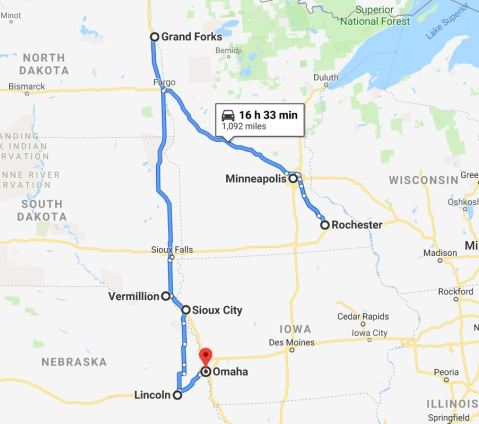



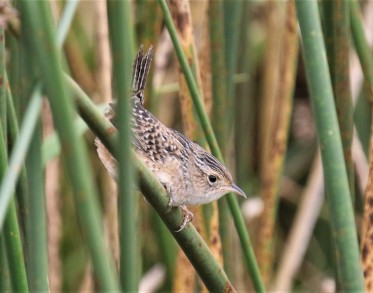












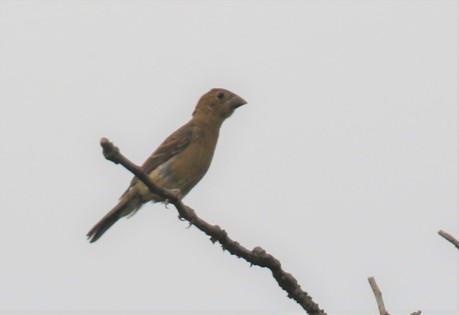
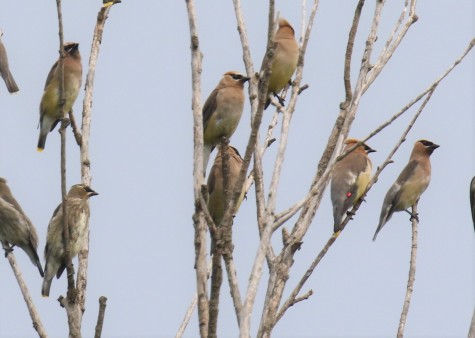




























 There were many swallows – five different species including another large group of Purple Martins. We also had a Nashville Warbler – photo resistant and my first Yellow Warbler of the trip.
There were many swallows – five different species including another large group of Purple Martins. We also had a Nashville Warbler – photo resistant and my first Yellow Warbler of the trip.



















